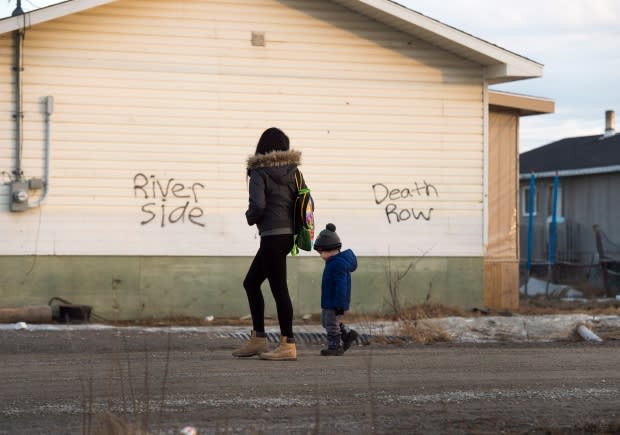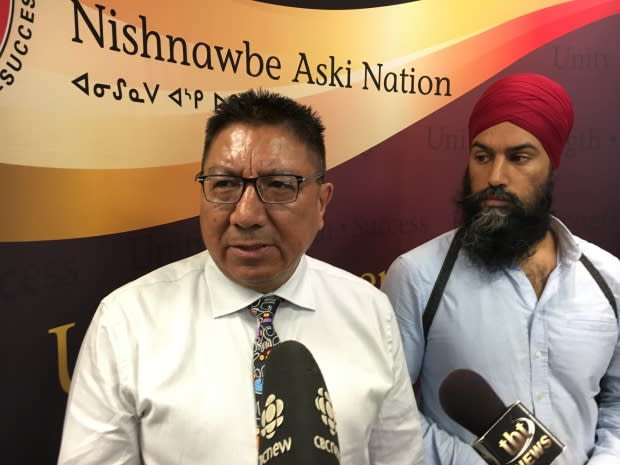Northern Ontario First Nations, federal NDP leader, renew calls for national suicide prevention strategy
Canada needs a national initiative aimed at preventing suicides, say Indigenous leaders representing dozens of First Nations across northern Ontario.
The renewed call comes in the wake of New Democrat MPP Sol Mamakwa rising in the Ontario legislature and speaking about a 13-year-old girl in Bearskin Lake First Nation who took her own life on Sept. 19. Mamakwa called the issue of Indigenous youth suicides a "pandemic."
Those calls were echoed by the leadership of the Nishnawbe Aski Nation (NAN) and the federal NDP on Sunday after a meeting in Thunder Bay between NAN Grand Chief Alvin Fiddler, NDP leader Jagmeet Singh, New Democrat MP Charlie Angus and Mamakwa. The Nishnawbe Aski Nation represents 49 First Nations across northern Ontario.
"We've been at this for so long now, the losses continue to happen," Fiddler said at a press conference after the meeting. "Families continue to suffer."
What NAN wants, Fiddler said, is a "comprehensive strategy on suicide prevention," led by the federal government but working hand-in-hand with the provinces and Indigenous leaders.

"All of us should be at a table to have this discussion and to work towards a plan that our communities can be a part of in developing some of these solutions."
Officials with NAN say its communities have reported close to 600 suicides since the mid-1980s, with about 90 of those deaths among youth aged 10 to 14. However, a spokesperson told CBC News in an email that the actual numbers are likely higher.
2017 was the worst year on record, officials added, with 38 reported suicides. 12 have been confirmed so far in 2018.
Angus and the NDP began a campaign in May for a national suicide prevention strategy, which would include Canada-wide guidelines for training frontline workers as well as components that promise to be culturally-appropriate. In 2011, when in opposition, the federal Liberals also pushed for a similar initiative, citing the need to have a coordinated response to a "stigmatized" and "silent problem."
On Sunday, Angus said the NDP will bring a motion to the House of Commons in November that will call on the federal government to "come to the table to be part of a national suicide action strategy."

"It can't be just an overall framework; this is an emergency, we have young people dying."
A strategy wouldn't just help First Nations, Angus said, as "horrific hotspots" of suicides are happening in "all manner of cultural groups, age groups, urban, rural [and] Indigenous [communities]."
"We are building alliances right now with the grassroots organizations who are coming up with the solutions," he continued. "The only thing that's missing right now is the federal government."
More improvements needed
Even though suicides are not exclusive to Indigenous communities, First Nations leaders have long been calling for other improvements to basic social infrastructure on-reserve — like clean water, adequate housing, as well as access to healthcare, education and fresh food — as crucial to helping prevent crises from repeating.
A number of Indigenous communities, including several in northern Ontario, have declared states of emergency in recent years due to high youth suicide rates.
A national strategy needs to take that into account, Fiddler said.
"When we talk about trying to improve quality of life for our children, you have to talk about housing, you have to talk about access to a quality healthcare system," he said. "In order for us to have this discussion, we need to talk about all those other things."
Those talks have to happen with Ottawa committing to reform the way it works with First Nations, Singh said, such as not challenging unfavourable rulings over its obligations to Indigenous communities in court.
"The way you solve the systemic problems [is] with respect, which means funding childcare, funding education, funding access to healthcare," he said.
"When these things are built up and there's a bright future and there's hope, that's how you eradicate some of the despair ... and the tragedy and trauma that leads to these horrible incidents."
Ottawa committed to 'wholistic' approach
Suicide prevention, particularly in First Nations, requires a "transformational approach," according to the office of Indigenous Services Minister Jane Philpott.
"We know that the roots of youth suicide in First Nations also derive from a range of social inequities in areas such as education, employment, housing and community infrastructure," press secretary Rachel Rappaport wrote in an email to CBC News.
"That's why we continue to work with communities in a wholistic way to address the social determinants of health and improve community well-being."
Rappaport said Ottawa has already supported initiatives that strengthen mental health services in Indigenous communities — including "culturally-appropriate services" like the Hope for Wellness phone line and online services — and are investing in crisis teams who support communities after a tragedy.

